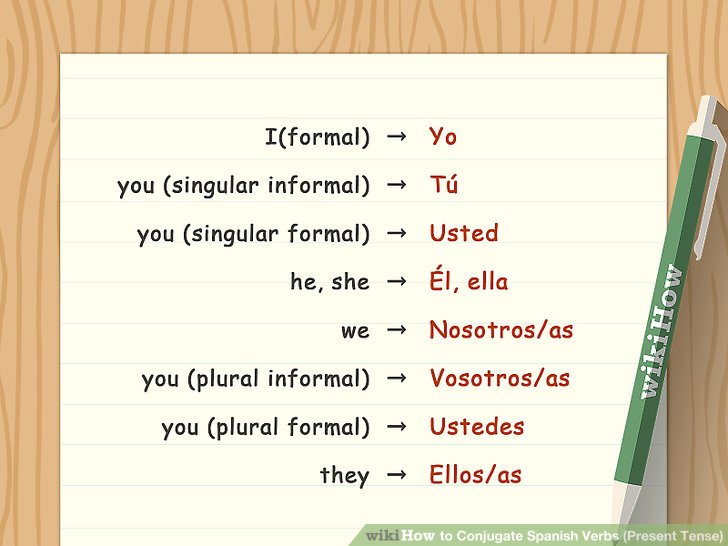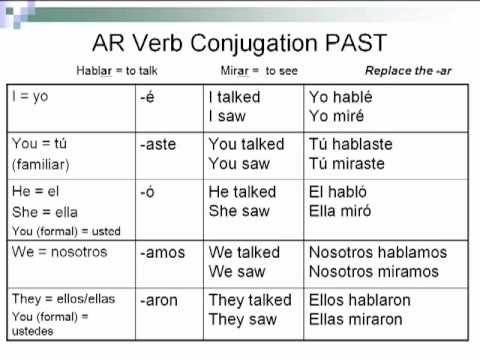Click to see all conjugation charts of hablar in every tense
In this conjugation lesson we will see how to inflect the verb hablar in the Presente tense of the Indicativo mood. It means we will see step by step how to create and translate forms of each grammatical person.
This lesson is specifically about the hablar conjugation. For a general overview of Simple Tenses conjugation see our Simple Tenses Conjugation Chart.
We also have a Video Presentation on how to conjugate verbs in Presente. It’s embedded below, but using the above link you may see additional information on conjugation in this tense as well as explanation of exceptions and special cases.
How to translate Presente to English
Notice that the English phrases provided below next to each conjugation are not direct translations from Spanish to English. They are usually the closest general equivalents. The example differences are:- In Spanish conjugation, there is the form usted in the third person singular. But this person does not translate to the English third person singular. It translates to the so called formal you and uses the inflected form which is most often represented as he/she/it in English conjugation charts.
- Similar situation happens in the third person plural, where ustedes translates to the English plural formal you but uses the form which corresponds to the they form in English.
- Tenses are used differently in Spanish and English, so the actual translation should always take into account the context and focus on translating the meaning, not just words.
- In both languages each verb may have multiple meanings and not every meaning translates directly to the other language. Here also, the context and focusing on the particular meaning helps to create the most accurate translation.
The Spanish Presente de Indicativo tense translates to one of the following:
- The English Present tense, for instance: yo habloI speak
- The English Present Progressive (also called Present Continuous) tense, for instance:ahora mismo yo habloI am speaking right now
Note however, that the Spanish equivalent of the Present Progressive also exists and is in common use – that’s Presente Progresivo (or Presente Continuo).
Note the timeline
The ability to correctly locate the intended position on the timeline is an important skill for proper use of tenses. So pay attention to the timeline in our lessons and visualize it while listening, speaking, reading or writing. After some practice you’ll be capable of selecting the right tense to use much easier.
Step by step instructions
Presente belongs to the simple tenses group, which means that all of its inflected forms are one word long. There are also compound (compuesto) tenses in Spanish language, where each inflected verb form consists of two words.The verb hablar has regular conjugation in the Presente tense of the Indicativo mood. It means this verb just follows the general rules for its group (-ar) without any exceptions, spelling corrections and the like. The basis for the conjugation in this tense is the stem of the verb, so we begin by splitting the infinitive into a stem and an ending. It’s really easy to do. Simply remove two letters from the end of the infinitive to get the ending — one of -ar, -er or -ir. What’s left is the stem. So for our verb:- the stem is: habl-
- and the ending is: -ar
- yo hablo – I speak
- tú hablas – you speak
- él habla – he speaks
- ella habla – she speaks
- usted habla – (formal) you speak
- nosotros hablamos – we speak
- nosotras hablamos – (feminine) we speak
- vosotros habláis – (plural) you speak
- vosotras habláis – (feminine, plural) you speak
- ellos hablan – they speak
- ellas hablan – (feminine) they speak
- ustedes hablan – (formal, plural) you speak
Hurray! The conjugation is now done. That’s the final result:
| yo | hablo | I speak |
| tú | hablas | you speak |
| él/ella/usted | habla | he/she/it speaks |
| nosotros/nosotras | hablamos | we speak |
| vosotros/vosotras | habláis | you speak |
| ellos/ellas/ustedes | hablan | they speak |
But do not end your session yet – it’s important to repeat and practice the material in order to remember it. Check below for example phrases and next steps.
Example sentences
Desde el accidente Pedro se emborracha cada día y no habla con nadie.
Since the accident Pedro gets drunk every day and doesn't talk to anyone.
Desconfío de los hombres que hablan de sí mismos en tercera persona.
I don't trust the men who talk about themselves in the third person.
- ¿Hablas español? ¿Puedo entrevistarte?
- Sí, pero después de que pague por el aparcamiento.
- Sí, pero después de que pague por el aparcamiento.
- Do you speak Spanish? May I interview you?
- Yes, after I pay for the parking.
- Yes, after I pay for the parking.
Hoy en día, si hablas de temas serios, la gente no te presta atención.
Nowadays, if you talk about serious issues, people do not pay attention.
- Cuídate, cariño. Hablamos pronto.
- ¡Chao tía!
- ¡Chao tía!
- Take care, love. We'll talk soon.
- Bye auntie!
- Bye auntie!
- ¿Ya habla tu niña?
- No, todavía no habla.
- No, todavía no habla.
- Does your girl speak yet?
- No, she doesn't speak yet.
- No, she doesn't speak yet.
Me pongo nerviosa cuando hablo contigo, pero es porque te amo.
I get nervous when I talk to you, but that's because I love you.
¿Te pones nervioso cuando hablas con alguien que te gusta?
Do you get nervous when you talk to someone you like?
Creo que habla demasiado.
I think he talks too much.
Ella siempre habla de mí.
She always talks about me.
Next Steps to Perfection
|
Report a mistake | Give feedback
Thank you very much for making the effort to contact us!
We strive to provide the highest quality content and we greatly appreciate even the smallest suggestions:
We strive to provide the highest quality content and we greatly appreciate even the smallest suggestions:



